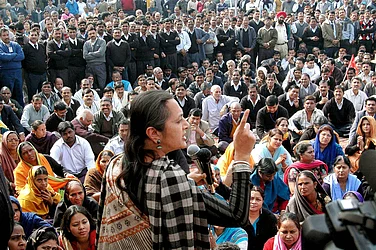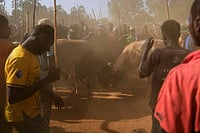Farmer, policeman, poet…Pawan Chamling has worn many hats over 69 springs. But for Sikkim, and the rest of India, it’s his achievements as a politician that makes him a superstar—in the fickle world of Indian politics, Chamling has been a CM for 25 years without a break, the longest ever. And he looks good to win another term as Sikkim voted on April 11 to elect a new assembly, along with two Lok Sabha members.
It has indeed been a long journey for Chamling since he fell out with his mentor Nar Bahadur Bhandari in 1993, and floated the Sikkim Democratic Front (SDF). As the lone member in the 32-member assembly, Chamling had staged the now famous protest on the floor of House by lighting a candle, symbolically “searching for democracy” in the “autocratic regime” of Bhandari.
The protest endeared Chamling to the people of the newly-minted state of Sikkim—which had merged into the Indian Union in 1975—and a groundswell of support propelled the farmer-poet to the “throne”; since dethroning Bhandari in 1994, Chamling has won the 2004, 2009 and 2014 assembly polls.
In 2014, the SDF won 22 seats, while the Sikkim Krantikari Morcha (SKM) founded by dissident SDF legislator Prem Singh Tamang won 10. In the outgoing assembly, SKM has only two legislators, with the rest defecting to the SDF. And the lone Independent MLA happens to be Chamling’s brother.
Chamling’s SDF has successfully combated anti-incumbency and the “parivartan” (change) cry of the Opposition by harping on peace and sustainable development. Known for his love for the environment, Chamling is often called the “greenest chief minister of India”. On his watch, Sikkim became the first state in India to start a green mission, managed to increase its forest cover.
A wily politician that he is, Chamling knows that dislodging him and the SDF from power—despite the strong incumbency factor—is not easy. “The SDF has a sound record in governance on virtually all fronts—from environment and sustainable development to gender equity, health and education,” Chamling had told Outlook in October 2018. Chamling’s political USP, in his own word is that he has also “delivered in maintaining peace in the sensitive border region”.
On the community-wise arithmetic, Chamling has got his maths right. The Sikkimese population of more than six lakh is distinctly divided into three separate ethnic groups—the Nepalis, who constitute more than 75 per cent, the ethnic tribes people, Bhutias and the Lepchas. Chamling has over the past three decades, nurtured this constituency among the Nepalis, with more than 70 per cent of whom belong to the other backward class (OBC) and the remaining to the upper castes. Chamling, who hails from the Rai sub-communality—an OBC—has nurtured over the years this section of the state’s population that has voted en masse for his SDF.
However, there is angst among Sikkim’s large unemployed pool of youngsters—fatigued by what they call appeasement politics of the Rai community, they want a regime change. Chamling rode to power with his “khali khute ko sarkar (government of the downtrodden) slogan. Now eyeing a record sixth consecutive term in office, Chamling is facing one of his toughest challenges. The answer if the poet-lyricist and politician will be able to turn the anti-incumbency tide is sealed in EVMs and will be known on May 23.
By Probir Pramanik in Calcutta


























